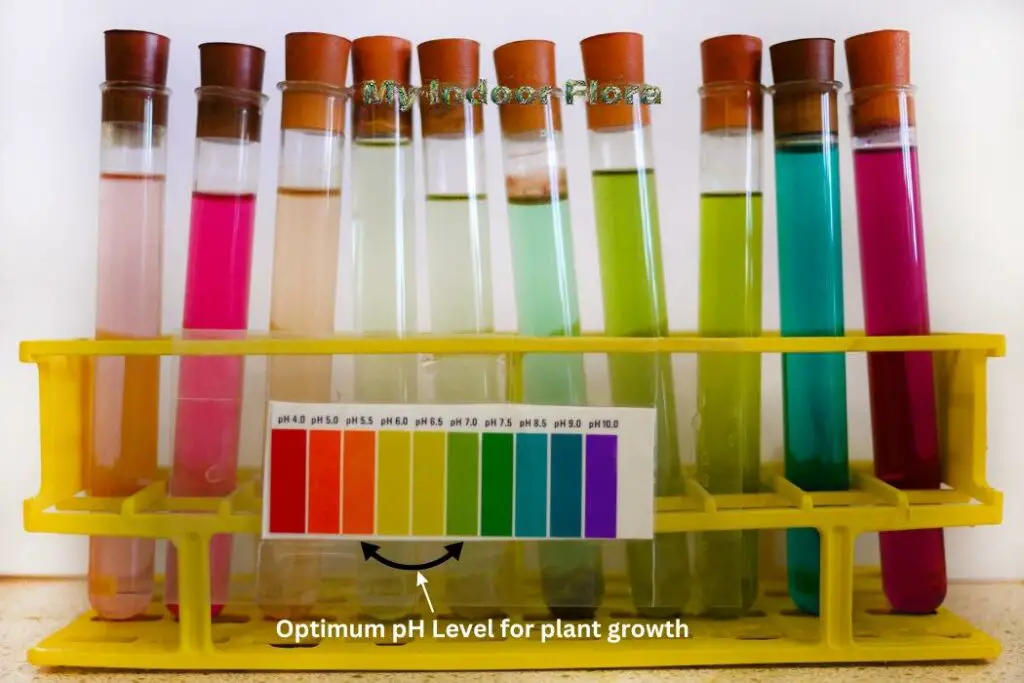The importance of pH levels (of the substrate) in indoor plant growth cannot be overstated, as it plays a critical role in nutrient availability and overall plant health. In this comprehensive guide, we will explore the impact of pH levels on indoor plant growth, backed by scientific research and expert insights.
According to a study published in the Journal of Horticultural Science and Biotechnology, improper pH levels can significantly impact plant growth, yield, and even susceptibility to diseases and pests. Understanding the optimal pH range for your specific plants and maintaining those levels is crucial for their healthy growth and development.
We will delve into the consequences of incorrect pH levels, methods for measuring and monitoring pH, and practical tips for adjusting pH levels when needed. Armed with this knowledge, you’ll be better equipped to create the ideal growing environment for your indoor plants, ensuring their health and vitality.

What are the Optimal pH Levels for Indoor Plant Growth?
The pH level of a growing medium significantly influences the health of indoor plants. It’s essential to understand the pH scale and how it affects nutrient availability in the growing medium. Additionally, it’s crucial to be aware of the general range of pH levels that are suitable for most indoor plants.
Understanding pH scale: acidity, neutrality, and alkalinity
The pH scale ranges from 0 to 14, with 7 being neutral. Values below 7 indicate acidity, while values above 7 indicate alkalinity. The pH level determines the availability of essential nutrients in the growing medium, which in turn affects plant growth and overall health.
According to a study published in the Journal of Plant Nutrition, the optimal pH range for most plants lies between 5.5 and 7.0. This range ensures that essential nutrients are available in the right proportions for plant growth.
The general range of pH levels suitable for most indoor plants
Most indoor plants prefer a slightly acidic to neutral pH range, typically between 5.5 and 7.0. However, certain plants, such as African violets, gardenias, and azaleas, prefer a more acidic environment, with a pH range of 4.5 to 5.5. Other plants, like spider plants and snake plants, can tolerate a slightly alkaline growing medium with a pH range of 7.0 to 7.5.
It is crucial to research the specific pH requirements of the plants you are growing indoors, as this will help you provide the most suitable environment for their growth.
Why optimal pH levels vary depending on the plant species
Different plant species have evolved to thrive in varying pH conditions. For instance, plants native to acidic soils, like blueberries and rhododendrons, have developed specialized root systems and nutrient uptake mechanisms that allow them to thrive in such environments. Similarly, plants native to alkaline soils, like lavender and cacti, have also evolved unique adaptations to succeed in their natural habitats.
Understanding these plant-specific adaptations and requirements is essential for providing the appropriate pH conditions for healthy indoor plant growth.

How do pH Levels Affect Nutrient Availability for Indoor Plants?
The pH level of the growing medium directly affects the availability of essential nutrients for plant growth. Let’s examine the role of pH in nutrient absorption and how different pH levels can lead to nutrient deficiencies or toxicities.
The role of pH in nutrient absorption
The pH level of a growing medium influences the solubility and availability of various nutrients. In general, macronutrients like nitrogen (N), phosphorus (P), and potassium (K) are more available in slightly acidic to neutral conditions (pH 5.5 to 7.0). Conversely, micronutrients such as iron (Fe), manganese (Mn), and zinc (Zn) are more available at lower pH levels.
As mentioned in a research paper published in the International Journal of Agronomy, when the pH level is too high or too low, certain nutrients become unavailable, leading to deficiencies that can negatively impact plant growth and health. It’s crucial to maintain the optimal pH range for your specific plants to ensure proper nutrient availability and uptake.
Specific nutrients affected by pH levels and their impact on plant growth
Some of the key nutrients that are affected by pH levels include:
- Nitrogen (N): Vital for plant growth and chlorophyll production, nitrogen is more available in slightly acidic to neutral pH levels. A deficiency in nitrogen can lead to poor growth and yellowing of leaves.
- Phosphorus (P): Essential for root development and energy transfer, phosphorus is also more available in slightly acidic to neutral pH levels. Phosphorus deficiency can cause stunted growth, poor flowering, and a dark green or purple coloration on leaves.
- Potassium (K): Crucial for water and nutrient movement in plants, potassium is more available in slightly acidic to neutral pH levels. A deficiency in potassium can result in weak stems, slow growth, and leaf curling or yellowing.
- Iron (Fe): Important for chlorophyll synthesis, iron is more available at lower pH levels. Iron deficiency can cause interveinal chlorosis, with leaves turning yellow while veins remain green.
- Manganese (Mn): Necessary for photosynthesis and enzyme activation, manganese is more available at lower pH levels. A deficiency in manganese can lead to interveinal chlorosis, similar to iron deficiency.
Understanding the availability of these nutrients at different pH levels is essential for maintaining proper nutrient balance in the growing medium.
How different pH levels can lead to nutrient deficiencies or toxicities
When the pH level is outside the optimal range for a specific plant, it can cause nutrient imbalances, leading to deficiencies or toxicities. For example, if the pH is too low (highly acidic), it can result in iron or manganese toxicity, while if the pH is too high (highly alkaline), it can cause deficiencies in nutrients such as phosphorus, iron, and manganese.
Maintaining the optimal pH range for your indoor plants is crucial to prevent these imbalances and ensure healthy growth.
What are the Consequences of Incorrect pH Levels for Indoor Plants?
Incorrect pH levels in the growing medium can have several negative consequences for indoor plants. Let’s explore the common symptoms of pH imbalance, the impact on plant growth and yield, and how pH imbalances can make plants more susceptible to diseases and pests.

Common symptoms of pH imbalance in plants
Some common symptoms of pH imbalance in indoor plants include:
- Yellowing or browning of leaves
- Poor root development
- Stunted growth
- Reduced flowering and fruit production
- Leaf curling or deformities
- Increased susceptibility to pests and diseases
If you notice any of these symptoms, it’s essential to check the pH level of the growing medium and make necessary adjustments.
Impact of pH levels on plant growth and yield
A study published in the Journal of Horticultural Science and Biotechnology found that improper pH levels can significantly impact plant growth and yield. When the pH is too high or too low, it can restrict nutrient availability, leading to stunted growth, reduced flowering, and poor fruit production. Furthermore, extreme pH levels can cause root damage, further inhibiting nutrient uptake and overall plant health.
How pH imbalances can make plants more susceptible to diseases and pests
A pH imbalance can weaken a plant’s immune system, making it more susceptible to diseases and pests. For example, a study in the Journal of Phytopathology found that plants grown in highly acidic conditions were more prone to fungal diseases like root rot. Similarly, plants grown in highly alkaline conditions can become more vulnerable to pests like spider mites and aphids.
By maintaining the proper pH levels, you can help ensure that your indoor plants have a strong defense system against diseases and pests.
How to Measure and Monitor pH Levels in Indoor Plant Growing Mediums?
Measuring and monitoring pH levels is an essential aspect of indoor plant care. Let’s discuss the different types of pH testing methods, the frequency of testing, and tips for accurate pH measurement and interpretation.
Types of pH testing methods: pH strips, pH meters, and soil test kits
There are several methods for measuring the pH level of your indoor plant’s growing medium:
- pH strips: Also known as litmus paper, pH strips are an affordable and straightforward method to test pH. Simply dip the strip into the soil or water sample, and compare the color change to the provided chart to determine the pH level.
- pH meters: These electronic devices provide a more accurate and precise pH measurement. Insert the probe into the soil or water sample, and the meter will display the pH level. While pH meters can be more expensive than pH strips, they offer greater accuracy and are reusable.
- Soil test kits: Soil test kits often include tests for pH as well as other important soil parameters like nutrient content. These kits typically involve mixing a soil sample with a provided reagent, and then comparing the color change to a reference chart to determine the pH level.
Each method has its advantages and drawbacks, so choose the one that best suits your needs and budget.
Frequency of pH testing for indoor plants
The frequency of pH testing depends on the specific needs of your plants and the stability of the growing medium. In general, it’s a good idea to test the pH levels at least once a month. However, if you are growing plants with more sensitive pH requirements or if you notice signs of nutrient imbalances, it may be necessary to test more frequently.
Tips for accurate pH measurement and interpretation
To ensure accurate pH measurement and interpretation, follow these tips:
- Always follow the manufacturer’s instructions for the pH testing method you’re using.
- Test the pH at different depths in the growing medium, as pH levels can vary.
- Take multiple samples from different areas of the growing medium to get a representative average.
- If using a pH meter, make sure to calibrate it regularly according to the manufacturer’s instructions.
- Keep a record of your pH measurements to track changes and trends over time.
By regularly measuring and monitoring the pH levels in your indoor plant’s growing medium, you can make informed decisions on how to maintain optimal growing conditions.
How to Adjust pH Levels in Indoor Plant Growing Mediums?
If your pH testing reveals that the growing medium is outside the optimal range for your plants, you may need to adjust the pH levels. Here, we’ll discuss methods for increasing or decreasing pH levels and the precautions and best practices to follow.
Methods to increase pH levels: using lime, wood ash, or baking soda
To raise the pH level of your growing medium, you can use one of the following methods:
- Lime: Applying ground limestone (calcium carbonate) or dolomitic lime (calcium magnesium carbonate) can effectively increase the pH level of acidic soils. Lime is slow-acting and should be mixed thoroughly into the growing medium for best results.
- Wood ash: Wood ash is an alkaline substance that can be used to raise the pH level. However, it can also increase the potassium content of the growing medium, so use it sparingly and with caution.
- Baking soda: Sodium bicarbonate (baking soda) can be used as a temporary solution to raise the pH level of water or hydroponic solutions. However, it should be used sparingly, as it can cause a buildup of sodium in the growing medium, which may be harmful to plants over time.
When using these methods, it’s essential to apply them incrementally and monitor the pH levels closely to avoid overshooting the desired pH range.
Methods to decrease pH levels: using sulfur, aluminum sulfate, or vinegar
To lower the pH level of your growing medium, consider one of the following methods:
- Sulfur: Elemental sulfur or sulfur compounds like ammonium sulfate can be used to lower the pH of alkaline soils. Sulfur reacts slowly with the soil and should be mixed thoroughly into the growing medium.
- Aluminum sulfate: Aluminum sulfate can be used to lower pH levels more quickly than sulfur, but it can also introduce high levels of aluminum into the soil, which can be toxic to plants if overused.
- Vinegar: Diluted white vinegar can be used as a temporary solution to lower the pH level of water or hydroponic solutions. Use this method sparingly and monitor the pH levels closely, as the effects of vinegar can be short-lived.
When using these methods, apply them gradually and keep a close eye on the pH levels to avoid creating an overly acidic environment for your plants.
Precautions and best practices when adjusting pH levels
When adjusting pH levels, follow these best practices and precautions:
- Always make incremental adjustments to avoid sudden, drastic changes in pH levels.
- Monitor the pH levels closely after each adjustment to ensure you’ve achieved the desired range.
- Be cautious when using substances that can introduce potentially harmful elements into the growing medium, like aluminum sulfate or wood ash.
- Research the specific pH requirements of your indoor plants to provide the most suitable environment for their growth.
By carefully adjusting pH levels and monitoring the results, you can create an optimal growing environment for your indoor plants.
Conclusion
Maintaining the proper pH levels is essential for the healthy growth and development of indoor plants. By understanding the optimal pH range for your plants, measuring and monitoring pH levels, and making necessary adjustments, you can ensure that your plants have access to the nutrients they need to thrive. Remember to research your specific plant species, monitor pH levels regularly, and follow best practices for adjusting pH levels to keep your indoor plants healthy and vibrant.
